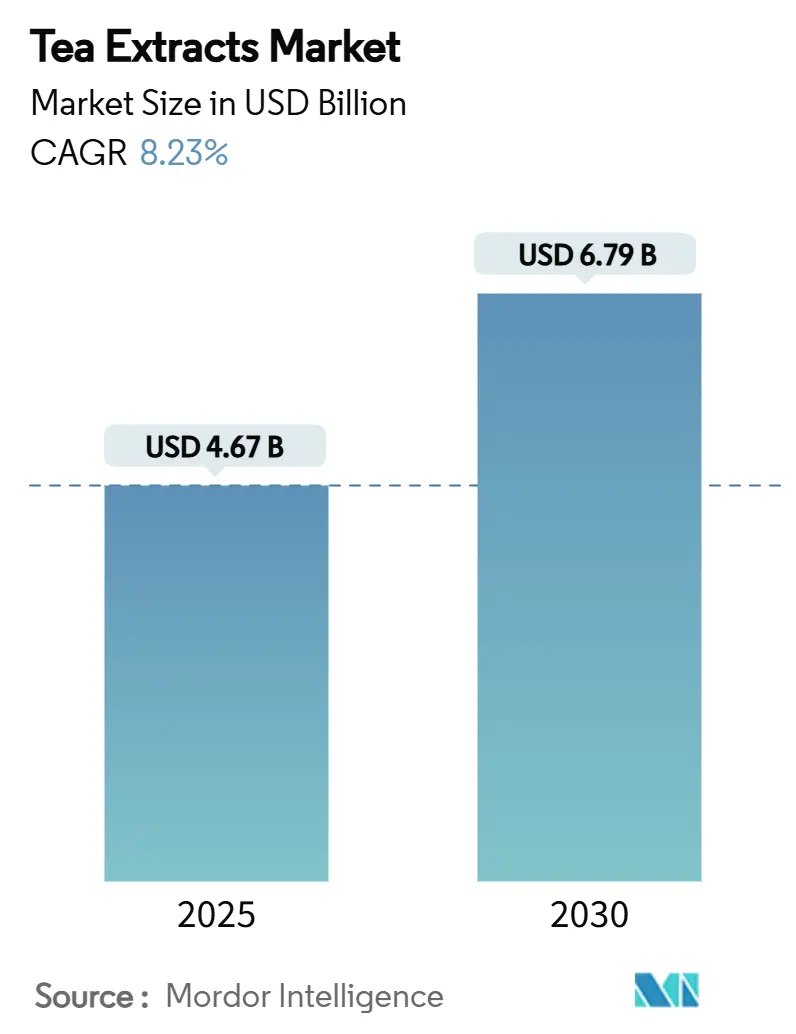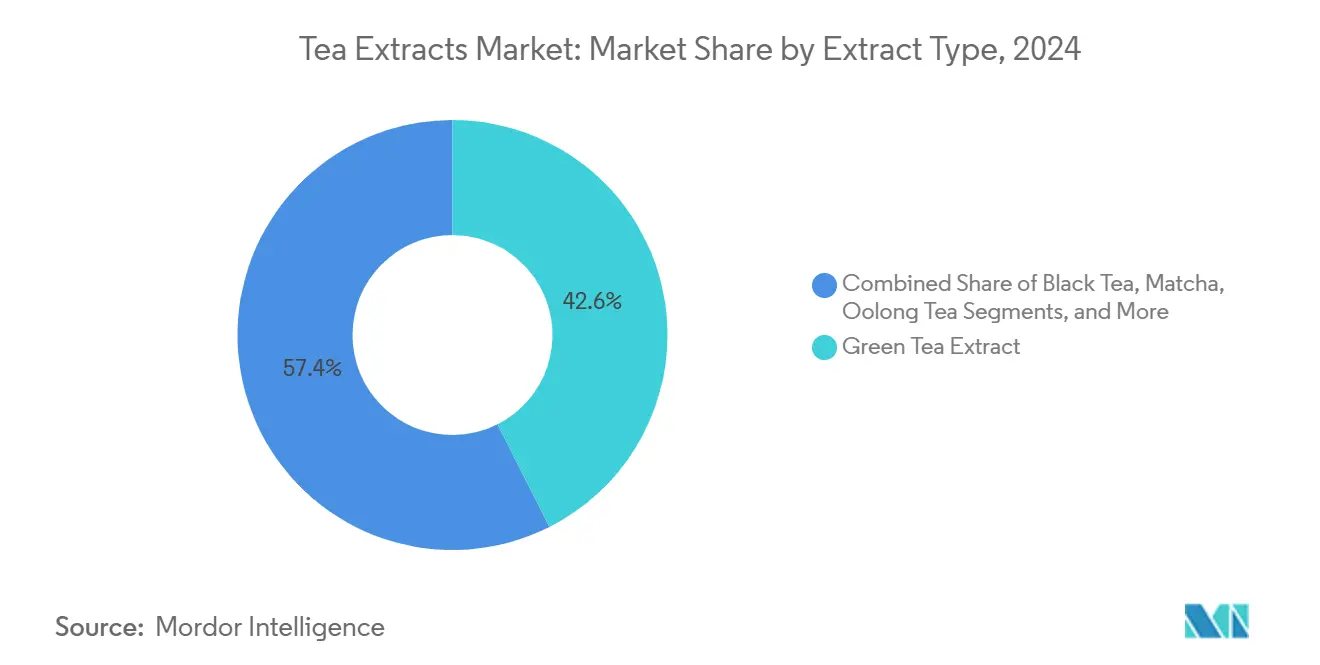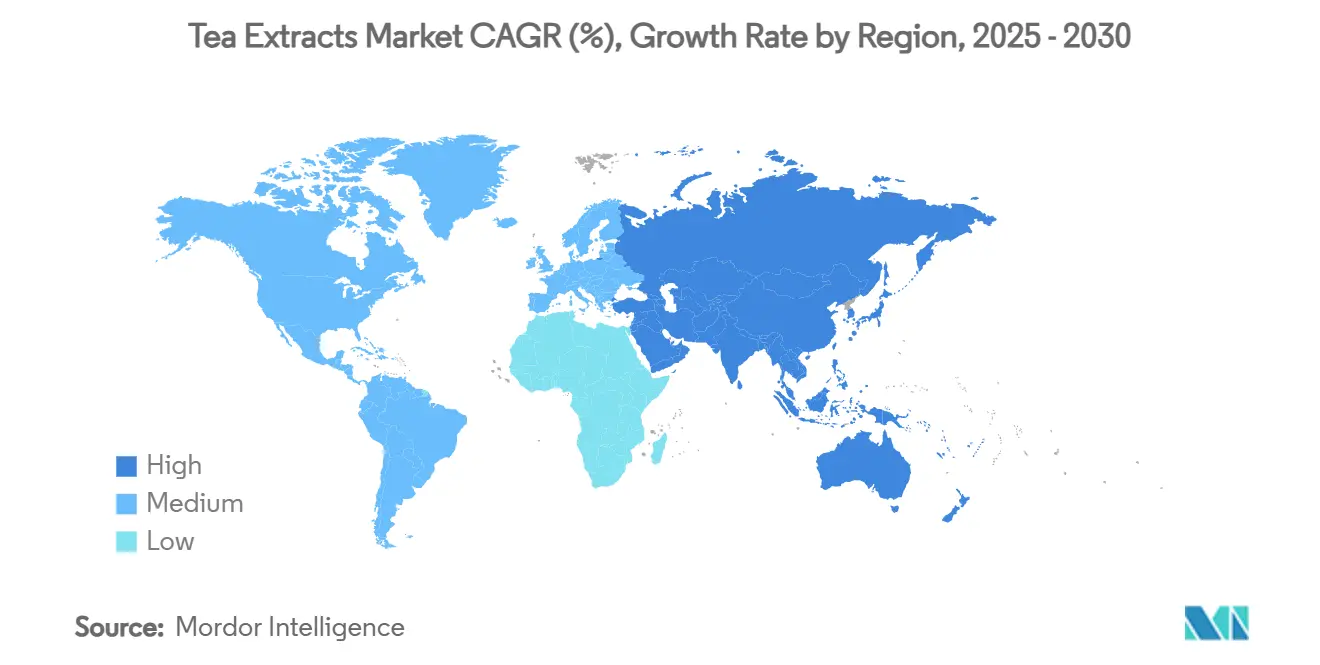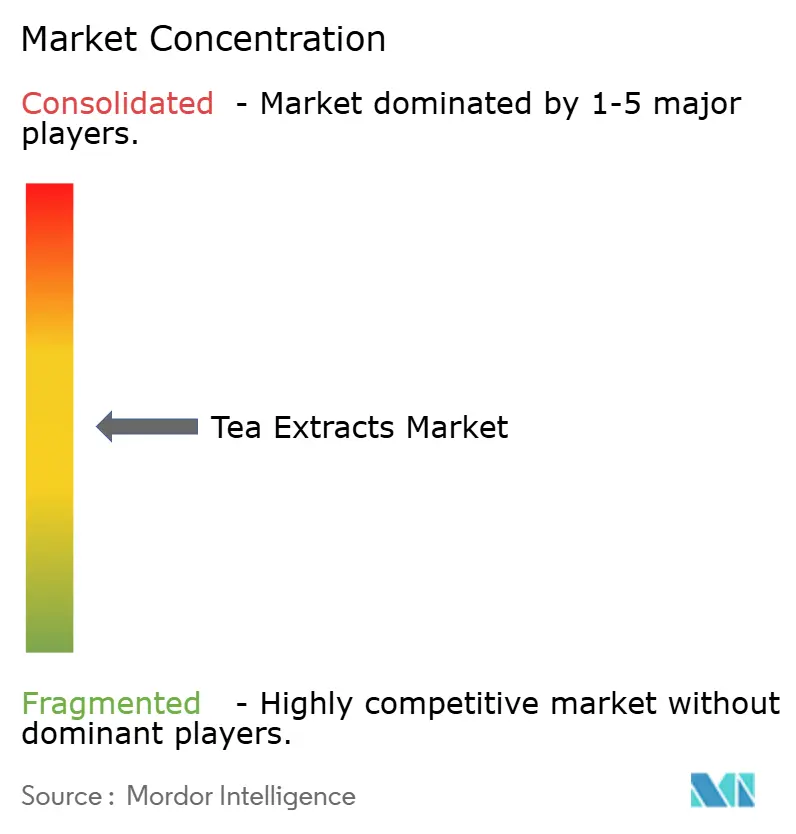Tea Extracts Market Size and Share

Tea Extracts Market Analysis by Mordor Intelligence
The tea extract market size reached USD 4.67 billion in 2025 and is forecast to attain USD 6.79 billion by 2030, translating to an 8.23% CAGR through the period. Strong demand for functional beverages, tightening clean-label regulations and ongoing product innovation anchor the growth trajectory. Regulatory milestones such as the United States FDA’s[1]U.S. Food and Drug Administration, “Tea Beverages Eligible for ‘Healthy’ Claim,” fda.gov December 2024 “healthy” claim for very-low-calorie tea beverages bolster industry confidence. Sustained investment in extraction and encapsulation technologies is improving bioactive stability and broadening application scopes, while climate-driven supply volatility is motivating firms to diversify sourcing and adopt climate-resilient cultivation practices. Competitive intensity remains moderate, yet technology-oriented entrants are narrowing the gap with established vertically integrated processors.
Key Report Takeaways
- By extract type, green tea extract led with a 42.56% share of the tea extract market in 2024, while matcha extracts are projected to rise at a 9.56% CAGR between 2025 and 2030.
- By form, the powder segment held 59.45% of the tea extract market share in 2024, whereas encapsulated and granular formats are expected to log a 10.34% CAGR through 2030.
- By application, food and beverages commanded 55.23% of the tea extract market share in 2024; ready-to-drink tea and coffee applications should accelerate at an 8.67% CAGR to 2030.
- By geography, Asia-Pacific accounted for 47.68% of the tea extract market in 2024 and is forecast to expand at a 9.89% CAGR during 2025–2030.
Global Tea Extracts Market Trends and Insights
Drivers Impact Analysis
| Drivers | (~) % Impact on CAGR Forecasts | Geographic Relevance | Impact Timeline |
|---|---|---|---|
| Rising demand for functional beverages with natural antioxidants | +1.8% | Global, with concentrated growth in North America & EU | Medium term (2-4 years) |
| Expanding nutraceutical adoption of tea-derived catechins | +1.2% | APAC core, spill-over to North America | Long term (≥ 4 years) |
| Clean-label shift from synthetic to natural food additives | +1.0% | Global, led by EU regulatory framework | Medium term (2-4 years) |
| Growing RTD tea & coffee launches featuring tea extracts | +0.8% | North America & APAC, expanding to EU | Short term (≤ 2 years) |
| Tea-extract natural colourants in plant-based meat analogues | +0.6% | North America & EU, early adoption in urban centers | Medium term (2-4 years) |
| Encapsulation of tea polyphenols in smart active packaging | +0.4% | Global, with early gains in Japan, Germany, United States | Long term (≥ 4 years) |
| Source: Mordor Intelligence | |||
Rising Demand for Functional Beverages with Natural Antioxidants
The functional beverage market is projected to reach USD 208.13 billion by 2024, reflecting consumers' increasing focus on health-conscious choices. Tea extracts have emerged as significant ingredients, offering antioxidant properties while meeting clean-label requirements. The FDA's approval of "healthy" labels for tea products has strengthened their market position and is influencing mainstream beverage formulations. Manufacturers are increasingly choosing natural tea-derived antioxidants over synthetic options in energy drinks, sports beverages, and wellness shots, due to their superior stability and bioavailability. Studies show that tea polyphenols are more effective when consumed in their natural form rather than as isolated compounds. This shift is particularly evident among younger consumers, who demonstrate a willingness to pay more for products with transparent ingredients and proven health benefits.
Expanding Nutraceutical Adoption of Tea-Derived Catechins
Tea-derived catechins have gained prominence in the nutraceutical market due to their scientifically validated health benefits, particularly epigallocatechin gallate (EGCG), which shows effectiveness in weight management, cardiovascular health, and cognitive function. Health Canada[2] Health Canada, “Permitted Supplemental Ingredients: Green Tea Extract,” canada.ca has established a 300 mg daily limit for EGCG in supplemental food ingredients to ensure consumer safety while acknowledging its therapeutic benefits. The FDA granted GRAS status to Kemin Industries' palmitoylated green tea catechins, indicating progress in improving bioavailability and stability for nutraceutical applications. Research evidence supporting catechins' benefits in metabolic health and neuroprotection has increased their use in dietary supplements, functional foods, and pharmaceuticals. The implementation of standardized extraction methods and quality control measures ensures consistent potency across product categories, facilitating the market's evolution toward evidence-based nutraceutical products.
Clean-Label Shift from Synthetic to Natural Food Additives
The clean-label movement has transformed food additive selection criteria, with tea extracts emerging as natural alternatives to synthetic preservatives and antioxidants in processed foods. The FDA's approval of butterfly pea flower extract as a color additive in 2025 demonstrates regulatory acceptance of natural colorants, establishing a framework for broader tea extract applications. Research shows that 73% of consumers actively seek products with recognizable ingredients, prompting manufacturers to substitute synthetic antioxidants like BHA and BHT with tea-derived alternatives that provide similar preservation benefits. The European Union's strict regulations on synthetic additives have increased the adoption of natural alternatives, as tea extracts offer both antioxidant and antimicrobial properties that extend shelf life while meeting clean-label standards. Food manufacturers now use tea extracts as both flavor enhancers and natural preservatives, allowing for simplified ingredient lists that appeal to health-conscious consumers.
Growing RTD Tea & Coffee Launches Featuring Tea Extracts
The ready-to-drink (RTD) tea and coffee segment is evolving through product innovation, with manufacturers incorporating tea extracts to enhance functional benefits and establish unique market positions. Companies are developing hybrid beverages that combine traditional tea properties with convenience, appealing to younger consumers seeking both health benefits and flavor. The integration of tea extracts enables manufacturers to create products that align with modern wellness trends while maintaining familiar taste profiles. The addition of adaptogens, functional mushrooms, and tea extracts is creating new beverage categories that combine refreshment and wellness properties. This diversification reflects the growing consumer demand for beverages that offer multiple functional benefits in a single serving. Manufacturers are developing RTD teas with biotic ingredients to support digestive health, responding to increased consumer awareness of gut health importance. Additionally, companies are formulating protein-enriched varieties for the fitness and recovery beverage market, capitalizing on the growing intersection between functional beverages and sports nutrition.
Restraint Impact Analysis
| Restraints | (~) % Impact on CAGR Forecasts | Geographic Relevance | Impact Timeline |
|---|---|---|---|
| Volatile tea-leaf supply & pricing from climate shifts | -0.9% | Global, with acute impacts in Kenya, India, Sri Lanka | Short term (≤ 2 years) |
| Stricter EGCG safety limits by global regulators | -0.7% | EU, North America, with spillover to APAC | Medium term (2-4 years) |
| Bitterness challenges at high inclusion levels in proteins | -0.5% | Global, particularly in sports nutrition applications | Medium term (2-4 years) |
| Substitution by alternative botanical antioxidants | -0.3% | North America & EU, driven by cost considerations | Long term (≥ 4 years) |
| Source: Mordor Intelligence | |||
Volatile Tea-Leaf Supply & Pricing from Climate Shifts
Climate change is disrupting tea cultivation patterns across major producing regions, with the FAO reporting significant yield reductions and quality variations that affect extract availability and pricing. Kenya's tea sector, which accounts for 26% of the country's export earnings, is particularly vulnerable to rising temperatures and changing precipitation patterns that impact both the quantity and quality of tea leaf production (Frontiers in Plant Science). Research indicates that a 2°C temperature increase by 2050 could reduce suitable tea cultivation areas by up to 25% in key producing regions, compelling manufacturers to diversify sourcing strategies and invest in climate-resilient cultivation practices (Agronomy). The resulting supply volatility has led extract manufacturers to develop alternative sourcing networks and invest in processing technologies that maximize yield from available raw materials. Price fluctuations caused by climate-induced scarcity present significant challenges for cost-sensitive applications, where tea extracts compete with synthetic alternatives.
Stricter EGCG Safety Limits by Global Regulators
The European Food Safety Authority identified hepatotoxicity risks in doses exceeding 800 mg per day, prompting comprehensive regulatory reviews across multiple jurisdictions. Health Canada responded by establishing a strict 300 mg daily limit for EGCG in supplemental foods, reflecting growing safety concerns. Australia's classification of green tea extract as a prohibited novel food in February 2025, citing significant liver toxicity concerns, indicates a broader regulatory trend that may restrict market access and impact industry growth. In response to these regulatory challenges, manufacturers are increasingly investing in advanced encapsulation technologies and sophisticated controlled-release formulations to optimize bioavailability while maintaining rigorous safety standards. The strategic shift toward lower-dose, higher-efficacy formulations enables companies to pursue premium positioning in the market while ensuring full compliance with evolving regulatory requirements.
Segment Analysis
By Extract Type: Green Tea Dominance Faces Matcha Disruption
Green tea extract holds 42.56% market share in 2024, supported by established supply chains and proven efficacy in functional applications. The extract's dominance is based on its documented catechin profile and regulatory acceptance across global markets, with GRAS status enabling widespread food and beverage applications. Black tea extracts maintain consistent demand in traditional applications, particularly in ready-to-drink beverages where their flavor profile enhances sweetener systems. Oolong tea extracts show increased adoption in nutraceutical applications due to their polyphenol composition, while white tea extracts secure premium pricing in cosmetic formulations based on their careful processing and antioxidant content.
Matcha extracts are growing at 9.56% CAGR through 2030, driven by premium positioning and increased use in cosmetic applications. This growth reflects consumer acceptance of premium pricing for quality and authenticity, with applications expanding into ice cream, confectionery, and skincare products. The segment's expansion is supported by processing techniques that maintain matcha's color and flavor while improving stability. Research on nano-encapsulation of EGCG with chitosan nanoparticles is enhancing bioavailability for functional foods and pharmaceuticals. Specialty varieties, such as butterfly pea flower extract, are gaining regulatory approvals for natural coloring applications, creating opportunities for product differentiation.

Note: Segment shares of all individual segments available upon report purchase
By Form: Powder Format Dominates with Growing Demand for Encapsulated Variants
The powder form holds 59.45% market share in 2024, driven by its cost-effectiveness and versatility in food and beverage applications. Encapsulated and granular formats show strong growth at 10.34% CAGR due to their enhanced stability and controlled-release properties. Powder formats remain dominant due to established manufacturing infrastructure and compatibility with existing food processing systems, making them suitable for large-scale commercial applications. Liquid extracts fulfill specific applications requiring immediate solubility and flavor integration, particularly in beverage concentrates and flavor systems. The liquid segment growth stems from improved concentration techniques that enhance shelf stability while preserving bioactive compounds.
Encapsulation technologies improve tea extract applications by addressing stability, bioavailability, and taste masking in functional foods. Chitosan-tripolyphosphate nanoparticles achieve 79% encapsulation efficiency for oolong tea extracts, enhancing their stability and penetration in cosmetic applications. Smart packaging systems with encapsulated tea polyphenols enable active food packaging applications, where antioxidant release extends product shelf life while providing health benefits. Granular formats gain traction in dietary supplement applications where precise dosing and extended release profiles meet consumer health requirements.
By Application: Food and Beverages Lead Tea Extract Applications, with RTD Segment Showing Strong Growth
Food and beverages hold a dominant 55.23% market share in 2024, as tea extracts serve both as flavor enhancers and natural preservatives. Ready-to-drink (RTD) tea and coffee applications show the highest growth rate at 8.67% CAGR through 2030, driven by increasing consumer preference for convenient functional beverages. The food and beverage sector's dominance is attributed to tea extracts' wide application range, from baked goods to processed meats, offering antioxidant protection while meeting clean-label demands. Dietary supplements present significant growth potential, especially in markets with supportive regulatory frameworks for tea-derived compound health claims. The market continues to expand in functional foods and bakery applications as manufacturers adopt natural alternatives to synthetic preservatives and flavor enhancers.
The RTD segment's expansion reflects changing beverage consumption trends, as consumers seek functional benefits in convenient formats. Chinese tea chains demonstrate the market potential, with Chagee generating USD 1.71 billion revenue in 2024 through premium tea-based beverages. The cosmetics and personal care sector benefits from research on tea polyphenols' anti-aging and skin protection properties, while pharmaceutical applications grow with increased clinical evidence supporting tea-derived compounds' therapeutic benefits. Animal feed applications emerge as a new opportunity, particularly in pet food formulations where botanical extracts replace synthetic additives.

Note: Segment shares of all individual segments available upon report purchase
Geography Analysis
Asia-Pacific holds 47.68% market share in 2024, supported by established tea cultivation infrastructure and increasing domestic consumption of functional beverages. The region shows the highest growth rate at 9.89% CAGR through 2030, driven by expanding middle-class populations and rising health awareness. India's Food Safety Standards Authority regulations for nutraceuticals create opportunities for tea extract use in functional foods and supplements. Japan's Foods with Function Claims system enables health claims for tea-derived compounds. The region's expansion is backed by investments in extraction technologies and quality control systems that align with international export standards.
North America's market continues to develop, with the FDA's December 2024 "healthy" label approval for tea products creating new functional beverage opportunities. The market shows increased adoption of tea extracts as natural alternatives to synthetic additives, supported by growing consumer awareness of health benefits. Canada's regulatory framework for supplemented foods includes specific guidelines for L-theanine and green tea extract, establishing clear pathways for product development. The region's advanced supply chain infrastructure supports premium tea extract applications.
Europe's strict safety requirements and health claim evaluations influence tea extract formulation innovation. The European Food Safety Authority's assessment of green tea catechin safety impacts product development, prompting manufacturers to invest in encapsulation technologies and controlled-release systems. The region's focus on clean-label products creates opportunities in food preservation and functional applications. The European Medicines Agency's[3]European Medicine Agency, "Camelliae sinensis non fermentatum folium - herbal medicinal product", www.ema.europa.eu herbal medicinal product framework enables therapeutic applications of tea-derived compounds. South America, Middle East, and Africa show potential as emerging markets due to increasing health awareness and expanding food processing industries, though their regulatory frameworks and supply chains remain in development.

Competitive Landscape
The tea extract market demonstrates moderate concentration with a 5 out of 10 rating. The competitive landscape consists of established botanical extract specialists and technology-focused companies developing new extraction and encapsulation methods. Market leaders such as Martin Bauer Group and Finlays implement vertical integration strategies from raw material sourcing to finished extract production, enabling quality control and cost optimization throughout the value chain.
Companies are increasing investments in sustainable sourcing practices, as evidenced by Martin Bauer Group's goal of climate neutrality by 2030 and the implementation of their mabagrown standard. The market also sees increased adoption of technology, with companies investing in advanced extraction techniques, encapsulation technologies, and quality control systems to enhance product consistency and expand their applications. The market presents opportunities in specialized applications, including smart packaging systems with tea polyphenols, plant-based meat colorants using tea extracts, and pharmaceutical-grade compounds for therapeutic uses.
Technology companies developing new delivery systems and startups focusing on premium positioning through innovative processing techniques are emerging as market disruptors. Established companies must innovate to maintain market share. Kemin Industries' FDA GRAS approval for palmitoylated green tea catechins illustrates how intellectual property and regulatory expertise provide competitive advantages in high-value applications. Companies are forming strategic partnerships to enhance processing capabilities and reduce waste, highlighting how technology partnerships enable operational excellence.
Tea Extracts Industry Leaders
-
Martin Bauer Group
-
Finlays
-
Taiyo International
-
Kemin Industries, Inc.
-
Synthite Group
- *Disclaimer: Major Players sorted in no particular order

Recent Industry Developments
- May 2025: Finlays, a provider of black tea extract, launched "Finlays Solutions," an evolved extracts business designed to provide comprehensive support to beverage operators and brands through advanced technology and consumer insights. The initiative represents a strategic shift toward customer-centric service delivery, emphasizing innovation and commercial viability in beverage solution development.
- October 2024: PLT Health Solutions expanded its portfolio by introducing cellflo6, a patented green tea (Camelia sinensis) extract. This ingredient is formulated to enhance energy, sports performance, and overall health benefits. Cellflo6 is a clinically studied, gallate-enhanced oligomer extract from green tea with standardized levels of galloylated procyanidins.
- July 2024: Mazza Innovation Ltd., which produces solvent-free botanical extracts, opened a commercial extraction facility to manufacture PhytoClean extracts from cranberry, green tea, and blueberry, along with other clean label ingredients.
- October 2023: MartinBauer, a leader in tea and botanical ingredients, unveiled a premium line of tea and botanical syrups tailored for beverage applications. The latest collection from MartinBauer features six distinct syrups, one of which is Black Tea. Emphasizing its dedication to quality, MartinBauer ensures that the product is devoid of artificial colors and flavors, underscoring its commitment to all-natural beverage solutions.
Global Tea Extracts Market Report Scope
| Green Tea |
| Black Tea |
| Oolong Tea |
| White Tea |
| Matcha Extract |
| Other Types |
| Powder |
| Liquid |
| Encapsulated/Granular |
| Functional Beverages |
| RTD Tea and Coffee |
| Dietary Supplements |
| Functional Foods and Bakery |
| Cosmetics and Personal Care |
| Pharmaceuticals |
| Animal feed |
| North America | United States |
| Canada | |
| Mexico | |
| Rest of North America | |
| Europe | Germany |
| United Kingdom | |
| Italy | |
| France | |
| Spain | |
| Netherlands | |
| Poland | |
| Belgium | |
| Sweden | |
| Rest of Europe | |
| Asia-Pacific | China |
| India | |
| Japan | |
| Australia | |
| Indonesia | |
| South Korea | |
| Thailand | |
| Singapore | |
| Rest of Asia-Pacific | |
| South America | Brazil |
| Argentina | |
| Colombia | |
| Chile | |
| Peru | |
| Rest of South America | |
| Middle East and Africa | South Africa |
| Saudi Arabia | |
| United Arab Emirates | |
| Nigeria | |
| Egypt | |
| Morocco | |
| Turkey | |
| Rest of Middle East and Africa |
| Extract Type | Green Tea | |
| Black Tea | ||
| Oolong Tea | ||
| White Tea | ||
| Matcha Extract | ||
| Other Types | ||
| Form | Powder | |
| Liquid | ||
| Encapsulated/Granular | ||
| Application | Functional Beverages | |
| RTD Tea and Coffee | ||
| Dietary Supplements | ||
| Functional Foods and Bakery | ||
| Cosmetics and Personal Care | ||
| Pharmaceuticals | ||
| Animal feed | ||
| Geography | North America | United States |
| Canada | ||
| Mexico | ||
| Rest of North America | ||
| Europe | Germany | |
| United Kingdom | ||
| Italy | ||
| France | ||
| Spain | ||
| Netherlands | ||
| Poland | ||
| Belgium | ||
| Sweden | ||
| Rest of Europe | ||
| Asia-Pacific | China | |
| India | ||
| Japan | ||
| Australia | ||
| Indonesia | ||
| South Korea | ||
| Thailand | ||
| Singapore | ||
| Rest of Asia-Pacific | ||
| South America | Brazil | |
| Argentina | ||
| Colombia | ||
| Chile | ||
| Peru | ||
| Rest of South America | ||
| Middle East and Africa | South Africa | |
| Saudi Arabia | ||
| United Arab Emirates | ||
| Nigeria | ||
| Egypt | ||
| Morocco | ||
| Turkey | ||
| Rest of Middle East and Africa | ||
Key Questions Answered in the Report
What is the current value of the tea extract market?
The market stood at USD 4.67 billion in 2025 with an 8.23% CAGR expected through 2030.
Which extract type leads global revenue?
Green tea extract accounted for 42.56% of 2024 sales, ahead of other tea varieties.
Why are encapsulated formats gaining traction?
Encapsulation improves polyphenol stability, masks bitterness and supports controlled release, enabling a forecast 10.34% CAGR for encapsulated and granular formats.
What regions offer the fastest growth prospects?
Asia-Pacific combines strong cultivation infrastructure with rising functional beverage demand, underlining a projected 9.89% CAGR to 2030.
Page last updated on:



